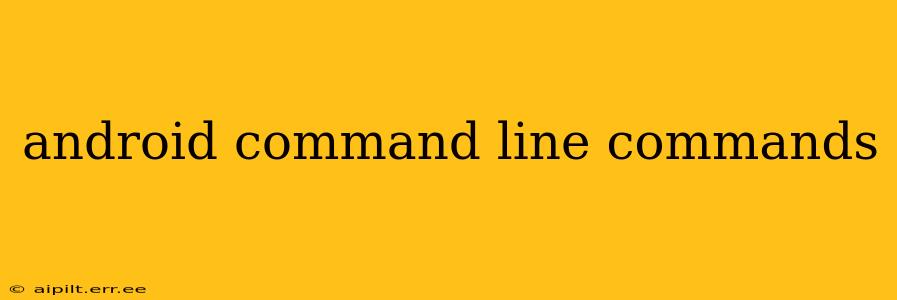Android's versatility extends beyond its user-friendly interface. A powerful command-line interface (CLI) offers advanced control and troubleshooting capabilities for developers and power users alike. This guide explores essential Android command-line commands, explaining their functionalities and practical applications. We'll delve into both common and less-known commands, empowering you to manage your Android device more effectively.
What is the Android Command Line Interface (CLI)?
The Android CLI provides a text-based interface to interact with your Android device or emulator. It's primarily used for tasks requiring precise control, such as debugging apps, managing files, and executing system-level commands. Access to the CLI typically requires connecting your Android device to your computer via USB debugging or using an emulator.
Essential Android Command Line Commands
Several commands are crucial for working with the Android CLI. Let's explore some key examples:
adb (Android Debug Bridge)
The adb command is the cornerstone of the Android CLI. It's a versatile tool that allows communication between your computer and your Android device. Most other commands rely on adb.
Common adb commands:
-
adb devices: Lists all connected Android devices and emulators. This is your first step to ensure your device is recognized. -
adb shell: Opens a shell on the Android device, allowing execution of Linux commands directly on the device. -
adb logcat: Displays system logs from the Android device, invaluable for debugging applications. You can filter logs using various options (e.g.,adb logcat -s MyTagto only show logs with "MyTag"). -
adb install <path_to_apk>: Installs an Android Package Kit (APK) file onto the device. -
adb uninstall <package_name>: Uninstalls an application from the device. Replace<package_name>with the application's package name (e.g.,com.example.myapp). -
adb push <local_path> <remote_path>: Copies a file from your computer to the Android device. -
adb pull <remote_path> <local_path>: Copies a file from the Android device to your computer. -
adb reboot: Restarts the Android device. You can also useadb reboot bootloaderto reboot into the bootloader.
Using adb shell for further commands
Once you've accessed the Android shell using adb shell, you can utilize standard Linux commands like:
-
ls: Lists files and directories. -
cd: Changes the current directory. -
mkdir: Creates a new directory. -
rm: Removes files or directories. -
ps: Lists running processes. -
top: Displays real-time system performance information.
Troubleshooting and Advanced Commands
Let's address some frequently asked questions and delve into more advanced commands.
How do I enable USB debugging on my Android device?
Enabling USB debugging is crucial for using the adb command. The process varies slightly depending on your Android version, but generally involves going to Settings > About Phone > Software Information, tapping the "Build Number" repeatedly until "Developer Options" appears in the Settings menu. Then, navigate to Developer Options and enable USB Debugging.
What are some advanced adb commands?
-
adb forward: Forwards local ports to remote ports on the device. This is useful for debugging network applications. -
adb shell am start: Starts an activity or broadcasts an intent. Used for automated testing and debugging.
How can I use adb with an emulator?
The process is similar to using adb with a physical device. Start the emulator first, and then execute the adb commands. adb devices should list the emulator instance.
What is the difference between adb install and adb uninstall?
adb install adds an APK to your Android device, whereas adb uninstall removes an application. You need the application's package name for the uninstall command.
Conclusion
The Android command line offers extensive control and functionality beyond the standard user interface. Mastering these commands empowers you to troubleshoot issues efficiently, manage your device effectively, and unlock advanced features often unavailable through the graphical interface. While this guide covers essential commands, further exploration and experimentation will unveil the full potential of the Android CLI. Remember to consult the official Android documentation for the most up-to-date information and details on specific command options.
